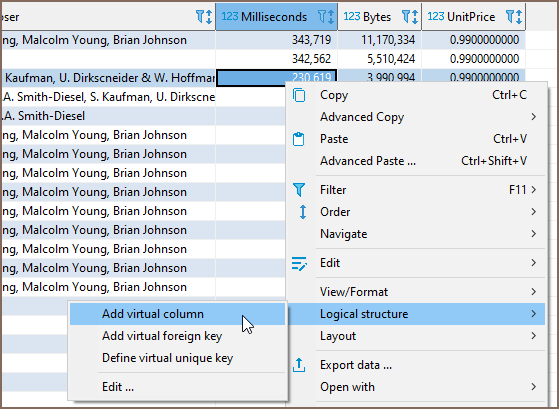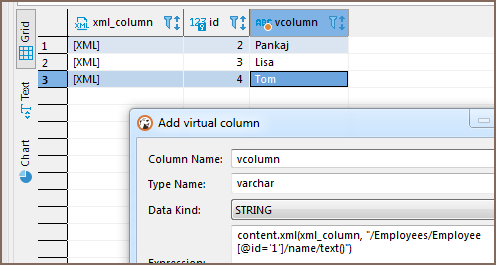Virtual column expressions
Table of contents
Expression language

You can use standard JavaScript-like expression language. DBeaver uses the Jexl engine to process expressions.
Language references and examples can be found here: http://commons.apache.org/proper/commons-jexl/reference/syntax.html
Column values
All columns' values in the current result set can be referred to by name.
Expression column1 + column2 will produce the sum of two numeric columns or concatenation of two string columns column and column2.
Standard functions
Standard functions are declared in namespaces.
You can refer to the functions in the namespaces as variables - nsName.functionName(parameters).
math
You can access all math functions as math.function(parameters).
You can find all supported math functions here: https://docs.oracle.com/cd/E12839_01/apirefs.1111/e12048/functmath.htm
geo
| Function | Parameters | Description |
|---|---|---|
| wktPoint | (longitude, latitude) | Produces WKT (geometry) point out of two coordinates. Default SRID is 4326. |
| wktPoint | (longitude, latitude, srid) | Produces WKT (geometry) point out of two coordinates and SRID |
content
If you have JSON or XML columns in your table, you can add a virtual column with an expression for these columns.
Use content.json(
Expression example: content.json(column1)['glossary']['GlossDiv']['title']
You can read more about JSON parameters in the link on the top.
Use content.xml(columnName, "expression") or content.xml(columnName, "returnType", "expression") patterns to create expression for XML column. The quotation is important for parsing processes. XML expression can return types: string, number, boolean, node, nodeset - all these types can be used (!in quotes) for return data type clarification. content.xml(columnName, "expression") returns string by default
Expression example: content.xml(column1, "nodeset", "/Employees/Employee[gender='Female']/name/text()")
You can read more about XPath here: https://en.wikipedia.org/wiki/XPath

Defining virtual keys
In cases where a table lacks a unique key, DBeaver provides the functionality to define a virtual key. This feature allows the creation of a custom set of columns that act as a unique identifier for table rows, facilitating the saving of changes in the absence of traditional unique constraints.
Refer to the Virtual Keys documentation for additional details on configuring and using virtual keys.
